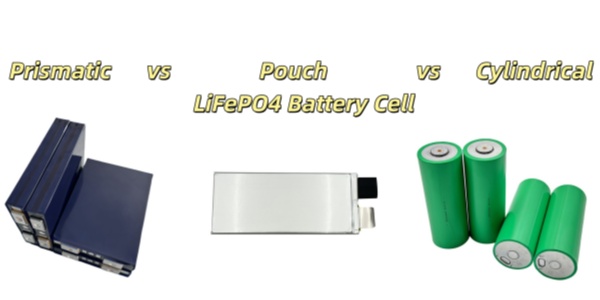LiFePO4 Batteries (LFP): The Best Choice for Improving Electric Vehicle Performance and Safety
Compared to traditional cars, electric vehicles (EVs) have many advantages, such as lower emissions, reduced fuel costs, and lower maintenance costs, making them increasingly popular and affordable. However, electric vehicles still face several challenges and limitations that prevent them from reaching their full potential and widespread adoption. One of the main challenges is the battery technology used in electric vehicles.

Most electric vehicles use lithium-ion batteries, which consist of various cathode, anode, and electrolyte materials. The cathode material determines the battery's performance and characteristics, such as energy density, power density, cycle life, and safety. The most common cathode materials for electric vehicle batteries are nickel manganese cobalt (NMC), nickel cobalt aluminum (NCA), and lithium iron phosphate (LFP). NMC and NCA batteries have higher energy and power densities, meaning they can store more energy in a given weight and volume, providing more power. This results in longer driving ranges and faster acceleration for electric vehicles. However, these batteries have shorter cycle lives and lower safety, meaning they degrade faster, are more prone to overheating, and have a higher risk of fire. Additionally, their cost and environmental impact are greater because they require scarce and expensive metals like nickel and cobalt, which are often mined under unethical and unsustainable conditions.
On the other hand, lithium iron phosphate (LFP) batteries have lower energy and power densities, meaning they store less energy and provide less power per unit of weight and volume. This results in shorter driving ranges and slower acceleration for electric vehicles. However, they also offer longer cycle lives and higher safety, meaning they last longer, are more stable, and are more resistant to thermal runaway. Moreover, they have lower costs and environmental impacts because they use abundant and inexpensive materials like iron and phosphate, which are easier to source and more environmentally friendly.
Therefore, LiFePO4 (LFP) batteries can overcome some of the challenges and limitations of other lithium-ion battery types, enhancing electric vehicle performance and reliability.
Advantages of using LFP batteries in electric vehicles
1. Faster Charging Speed
LFP batteries charge faster than other types of lithium batteries because they have lower internal resistance and higher thermal stability. This allows them to accept higher current without overheating or damaging the battery. For example, a Tesla Model 3 equipped with an LFP battery can charge from 10% to 80% in about 27 minutes, while a Model 3 with an NCA battery requires about 37 minutes.
2. Higher Power Density
LFP batteries have higher discharge rates and lower voltage sag, allowing them to provide higher power density than other lithium battery types. This means they can deliver more power without losing voltage or capacity. For example, a BYD e6 with an LFP battery can accelerate from 0 to 100 km/h in about 8 seconds, while a Nissan Leaf with an NMC battery takes about 10 seconds.
3. Lighter Weight
LFP batteries have higher specific energy and lower packaging requirements, which reduce the overall weight of the electric vehicle. This means they can store more energy per unit of weight and require less space and material for packaging and protection. For instance, a Renault Zoe with an LFP battery weighs about 1,468 kg, while a Zoe with an NMC battery weighs about 1,635 kg.
4. Higher Safety
LFP batteries offer better thermal stability and lower flammability, improving the safety of electric vehicles. This means they are less likely to overheat, catch fire, or explode in case of misuse or an accident. For example, a Tesla Model 3 with an LFP battery has a lower risk of thermal runaway compared to a Model 3 with an NCA battery because the LFP battery can withstand higher temperatures and has a higher melting point.
5. Environmental and Cost Benefits
LFP batteries are more cost-effective compared to NMC and NCA batteries due to the lower cost of their raw materials, such as iron and phosphate. These materials are abundant and easy to source, making LFP batteries a more environmentally friendly and sustainable option. Additionally, the mining of iron and phosphate has a significantly lower environmental impact than the mining of nickel and cobalt.
Applications of LFP Batteries
In addition to electric vehicles, lithium iron phosphate batteries are also used in other applications, such as energy storage, backup power, and portable power solutions. LFP batteries provide reliable, efficient, and safe power for solar panels, inverters, chargers, generators, and various other systems.
Conclusion: LFP Batteries – The Future of Electric Vehicles
In conclusion, lithium iron phosphate (LFP) batteries are the future of electric vehicles because they address many of the challenges and limitations of other lithium battery types, enhancing electric vehicle performance and reliability. LFP batteries also have a broad range of applications, such as energy storage, backup power, and portable power. They offer faster charging speeds, higher power density, lighter weight, and greater safety for electric vehicles and other systems. Leading electric vehicle manufacturers, such as Tesla, BYD, and Renault, have already adopted LFP batteries in their models, particularly in low-end and mid-range vehicles. As LFP battery technology continues to advance, it is expected to become more widespread and capture a larger share of the market.

